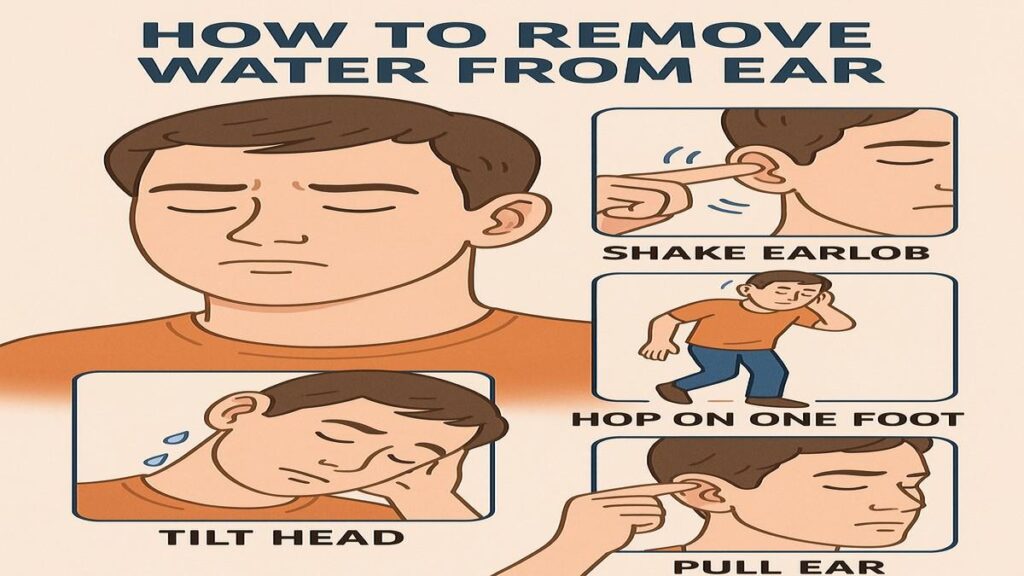
How to Remove Water from Ear: Easy Tips and Effective Solutions
Getting a water stitch in your ear can be both uncomfortable and risky if not addressed quickly. Whether it’s from swimming, showering, or getting caught in the rain, the blocked sensation and reduced hearing can be frustrating. The good news is that you no longer have to wait for so long. In this article, we explain safe, easy, and effective ways to remove water from the ear. These simple techniques offer quick relief and help prevent issues like infections, irritation, or temporary hearing loss, so you can feel normal again.
Why Does Water Get Trapped in the Ears?
Ear water trapping is common due to reasons:
- Narrow Ear Canals: Some people have ear canals that are narrow by nature, meaning it is easier for water to get stuck in the ear.
- Build Up of Ear Wax: Ear wax buildup can keep water from coming out of the ear and keep it in the ear.
- Swimming/Bathing: Oftentimes, when you put your head under water, your ears will get some water in them, no matter how often you try to make it not.
- Ear Infections/Inflammation: Having an Ear infection or inflammation can change the shape of the ears, changing where the water can get trapped inside your ear.
- Improper Ear Drying: Rubbing the ear or using cotton swabs or other items can push the water deeper into the ear canal, making it harder to remove.
Read Also: Ear Pain in Cold and how cold weather can affect your ear health.
How to Remove Water From The Ear: Easy Step-by-Step Techniques
Tilt and Shake Method
This is the easiest way to remove water naturally.
Steps:
- Tilt your head sideways with the affected ear facing down.
- Gently pull your earlobe to open the ear canal.
- Shake your head lightly to help water drain out.
Best for water trapped in the outer ear.
Use Over-the-Counter Ear Drops
Ear drops with alcohol or glycerin help dry up water, especially if you have narrow ear canals or excess wax.
Steps:
- Tilt your head with the affected ear facing up.
- Add 2–3 drops of the ear-drying solution.
- Keep your head tilted for a few minutes.
- Then tilt the other way to let the water drain.
Try the Valsalva Manoeuvre
This method equalises pressure to help release water.
Steps:
- Inhale deeply.
- Pinch your nose and close your mouth.
- Gently blow through your nose.
- Stop once you feel a slight pop.
Warning: Never blow too hard to avoid damaging your eardrum.
Apply a Warm Compress
Warmth can relax ear muscles and promote drainage.
Steps:
- Soak a clean cloth in warm water and wring it out.
- Place it over the affected ear for 5–10 minutes.
- Then tilt your head to drain the water.
Use a Hair Dryer
Warm air can evaporate trapped water.
Steps:
- Set your dryer to low heat and speed.
- Hold it about 12 inches from your ear.
- Blow warm air toward the ear for 30 seconds.
Create a Vacuum with Your Palm
This method uses suction to pull out water.
Steps:
- Cup your palm over the ear to form a seal.
- Gently push and release your hand to create a vacuum.
- Continue until the water starts to drain.
Risks of Trapped Water in the Ear
Water stuck in the ear for days may lead to discomfort, but the risks go beyond that:
- Swimmer’s Ear: Prolonged water exposure can lead to bacterial growth, causing an ear infection known as swimmer’s ear. Symptoms include itching, redness, and pain.
- Hearing Issues: Temporary muffled hearing can occur due to the blockage.
- Chronic Infections: If left untreated, repeated infections can damage the ear canal or eardrum, potentially leading to hearing loss.
Prevention Tips to Avoid Water in the Ear
Preventing water from getting trapped in your ears is always better than treating it later.
|
Do’s |
Don’t |
|
Use swim plugs or earplugs. |
Insert cotton swabs into your ear. |
|
Dry your ears thoroughly after water. |
Use sharp objects to clean your ears. |
|
Tilt your head to drain water. |
Ignore persistent ear discomfort. |
When to Seek Medical Help
Sometimes, home remedies aren’t enough. Seek professional help if you experience:
- Persistent Ear Pain: Continuous pain could indicate an infection.
- Muffled Hearing: If your hearing doesn’t return to normal.
- Signs of Infection: Redness, swelling, or discharge from the ear.
The Hearing care clinic in Delhi offers expert consultation and treatments for all ear-related issues.
Read: Which Cell Keeps Your Hearing Aids Running
Conclusion
Water trapped in the ear can be uncomfortable, but you can try many of these easy techniques. If the issue does not resolve on its own or you have repeated occurrences, visit the Hearing Aid Centre in Delhi or book a hearing test to safely manage your ear health and avoid permanent complications. Seeking urgent care provides your ears with long-term relaxed comfort and care!
Frequently Asked Questions
One of the fastest ways to remove water from your ear is to tilt your head to the affected side and gently tug on your earlobe. This straightens the ear canal and allows gravity to help the water drain out. You can also try hopping on one foot on the same side to encourage the water to escape.
To remove trapped water, you can try several methods:
-
Tilt your head and pull on your earlobe.
-
Use the “vacuum technique” by cupping your palm over the ear and gently pushing in and out to create suction.
-
Lie down on your side for a few minutes with the affected ear facing downward.
-
Use over-the-counter drying drops or a mixture of equal parts rubbing alcohol and vinegar.
If the water doesn’t come out after trying these, consult a healthcare professional.
Water can get stuck in your ear when it enters the ear canal and becomes trapped by earwax, tight ear canal structure, or surface tension. This commonly happens after swimming, bathing, or showering. In some cases, lying in certain positions can also cause water to become lodged in the ear.
Water typically drains from the ear within a few minutes to a few hours. However, if it becomes trapped, it may stay for a day or longer. If water remains in your ear for more than 24–48 hours, it may lead to an ear infection and should be checked by a healthcare provider.
To unblock water in the ear, you can try the following:
-
Tilt your head and let gravity do the work.
-
Use a warm compress to help open the Eustachian tube.
-
Try yawning or chewing gum to relieve pressure and open the ear canal.
-
Use ear drops designed to dry out moisture.
If these steps don’t help, seek medical attention to avoid complications.
Dr. Harshi, is an accomplished Audiologist with extensive expertise in treating individuals with hearing impairments.

